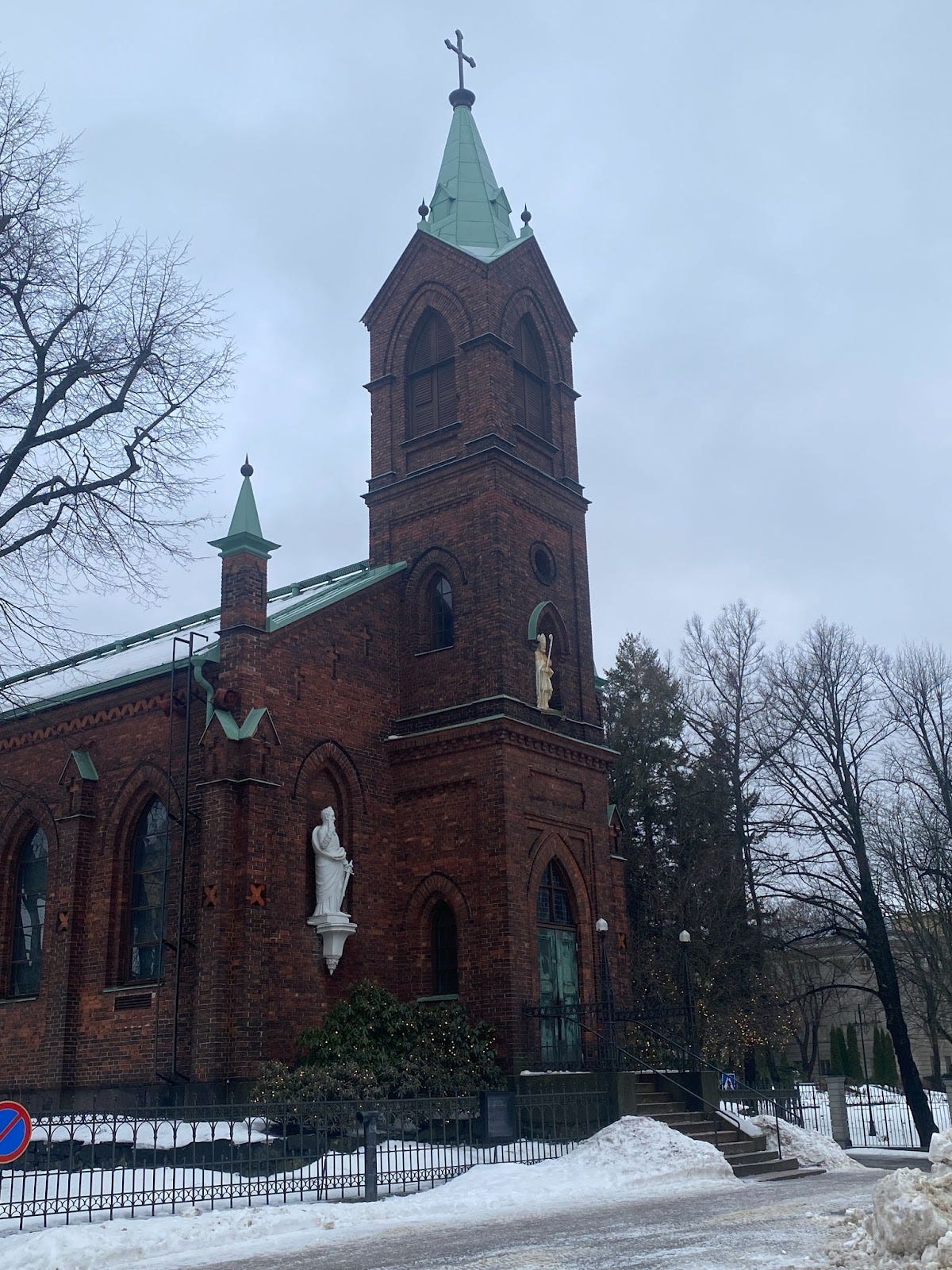I get to Helsinki on Wednesday evening.
The whole city is covered in snow when I arrive, with drifts up to two feet tall.
It’s the first time I’ve seen this much snow in my life. I come from one of the hottest cities in the world. I’m a student in the Netherlands now, but the Netherlands doesn’t really have much snow anymore.
Despite the snow on the ground, the temperature is warming up when I get to Helsinki. The thermometer hovers around 30 degrees Fahrenheit. While I’m bundled up in a parka and gloves, I see Finlanders out in light sweaters. They’re enjoying the balmy Scandinavian January.
With my scarf and hat, I make my way from the airport to St. Henry ‘s Cathedral, where Fr. Jean Claude Kabeza, the parish priest, will receive me.
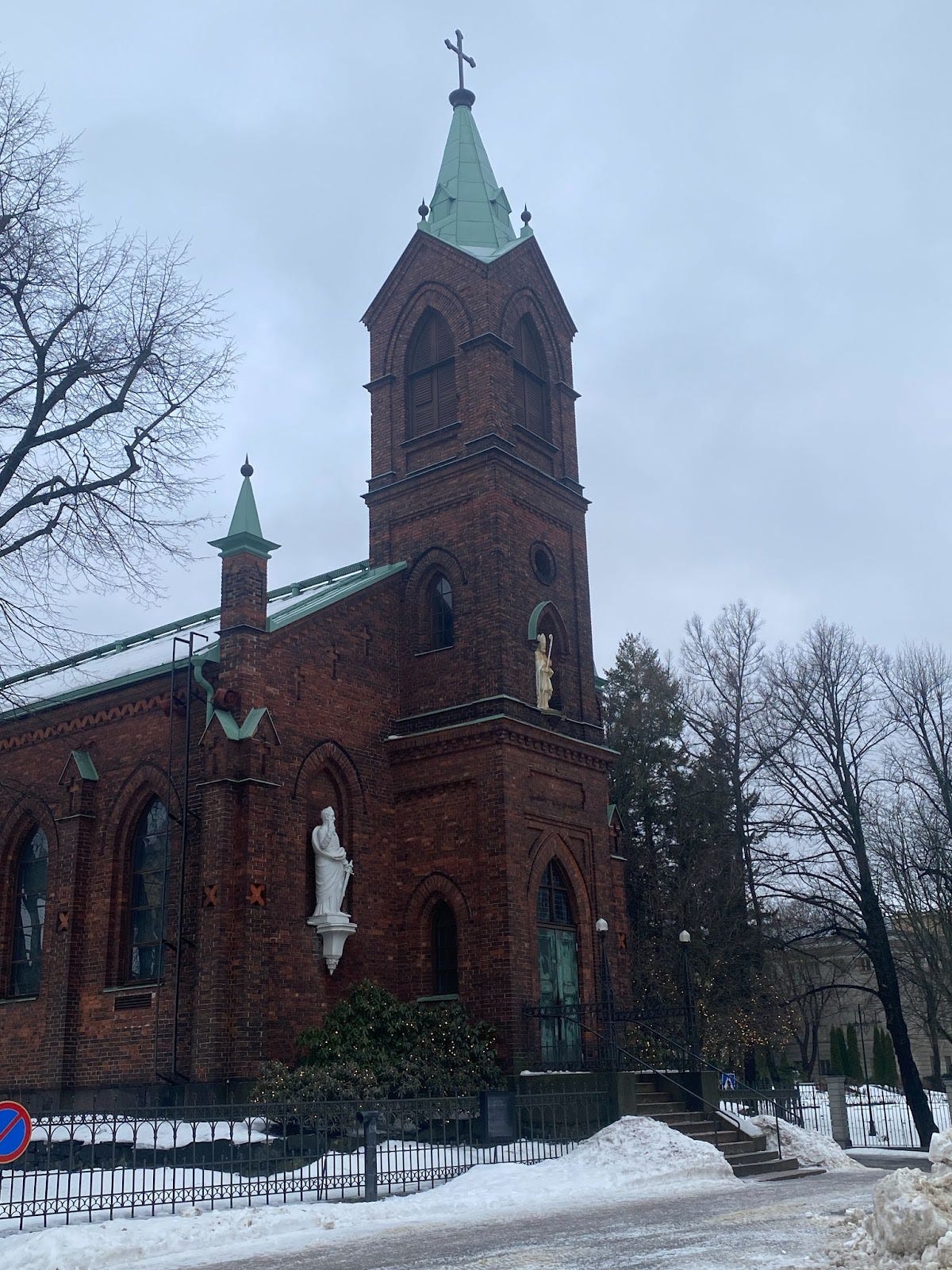
Isä Jean Claude – Father Jean Claude, to us – is originally from Rwanda. He came to Finland as a seminarian and refugee.
After we visit for a while, the priest shows me to a guest room. He tells me there’s Mass the next morning.
“But it’s in Finnish,” he warns. I joke that I’m used to attending Mass in Dutch, another language I don’t understand.
I wake up for Mass the next day. I have a good grasp of languages, I wonder if I might get a word or two out of the homily. But Finnish seems unintelligible.
I soon see why, along with Basque and Hungarian, Finnish is considered one of the most difficult European languages to learn.
I’m guessing I understand how the pagan Finns felt when they saw Saint Henry – the country’s patron saint and one of the first apostles to the country – celebrating the Mass in Latin.
The following day, I visit the cathedral. It’s a beautiful church built in the 19th century to serve Ukrainian, Polish, and Baltic Catholics working in the Russian Imperial army. Countess Leopoldina Cicogna, the Italian-born spouse of the Governor General of Finland, Friedrich von Berg, was a devout Catholic and funded the building of the church in the 1850s.
But it is small for a cathedral. In fact, it’s small for a parish. It’s smaller than most parishes I’ve seen in Venezuela or the Netherlands. Or pretty much anywhere.
“In spring and summer, when the weather is better, sometimes people have to stand outside of the church, in the stairway during holy Mass because of how full the church is during Mass,” Isä Jean Claude – who is also vicar general of the diocese – tells me.
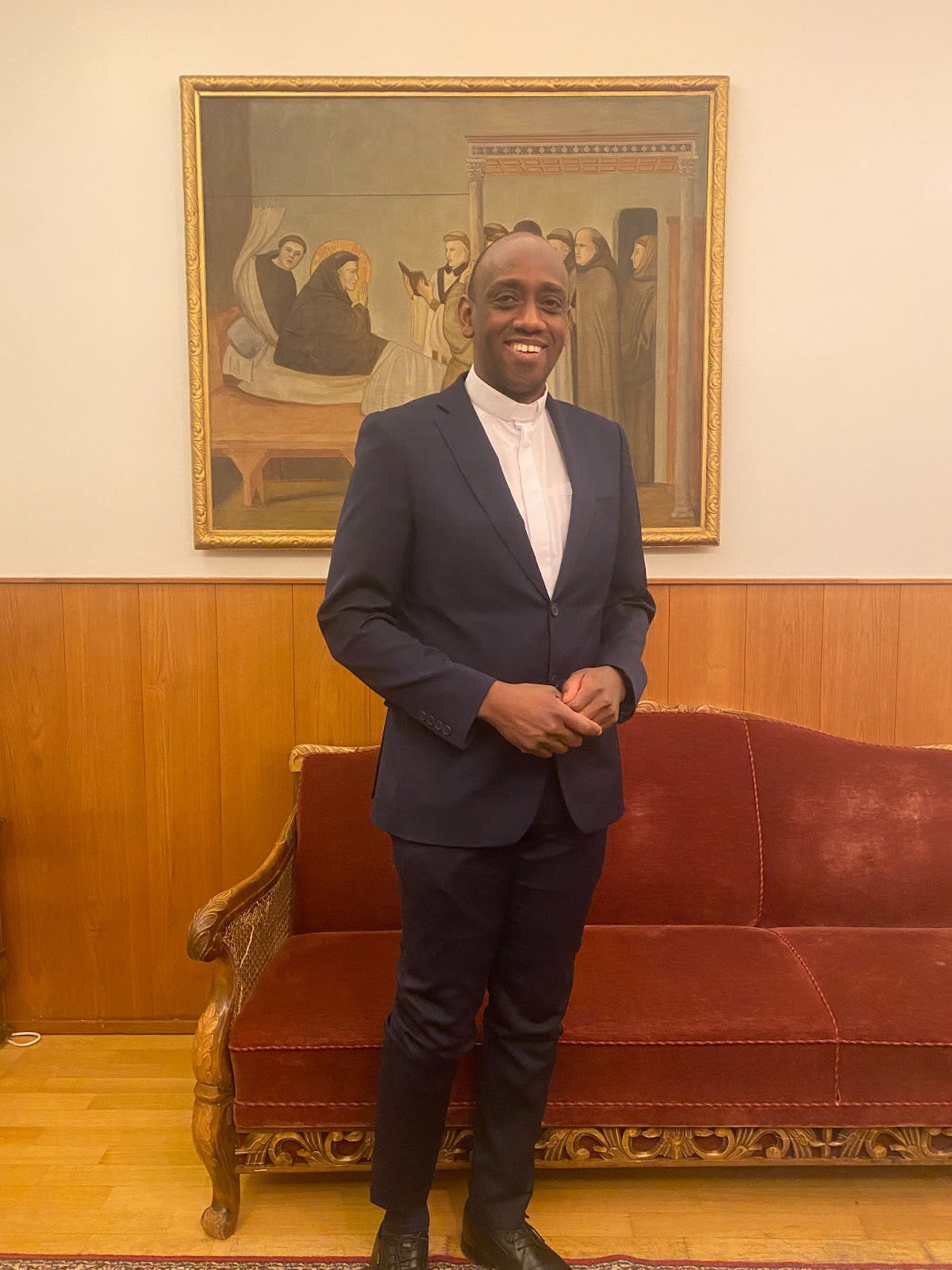
But however small the church, the cathedral’s ministry is booming – it is perhaps one of the most international parishes in Europe, with people from 82 different countries attending Mass at the parish.
“We have Mass in English and Finnish every week,” Fr. Kabeza tells me. “Then sometimes weekly, sometimes biweekly, sometimes monthly, we also have Divine Liturgy in Ukrainian, Mass in Italian, in Tagalog, in Russian, in Vietnamese, in Hungarian, in Spanish and in Swedish. I also celebrate in Kinyarwanda privately sometimes, and we have the Traditional Latin Mass. So, off the top of my mind, that is 11 languages.”
“And in other parishes we have Mass in Polish, German, Portuguese, and Tamil. We have Catholic communities from India and Myanmar who speak different languages, and also have Mass in their languages. And maybe I’m forgetting a couple of languages,” he adds.
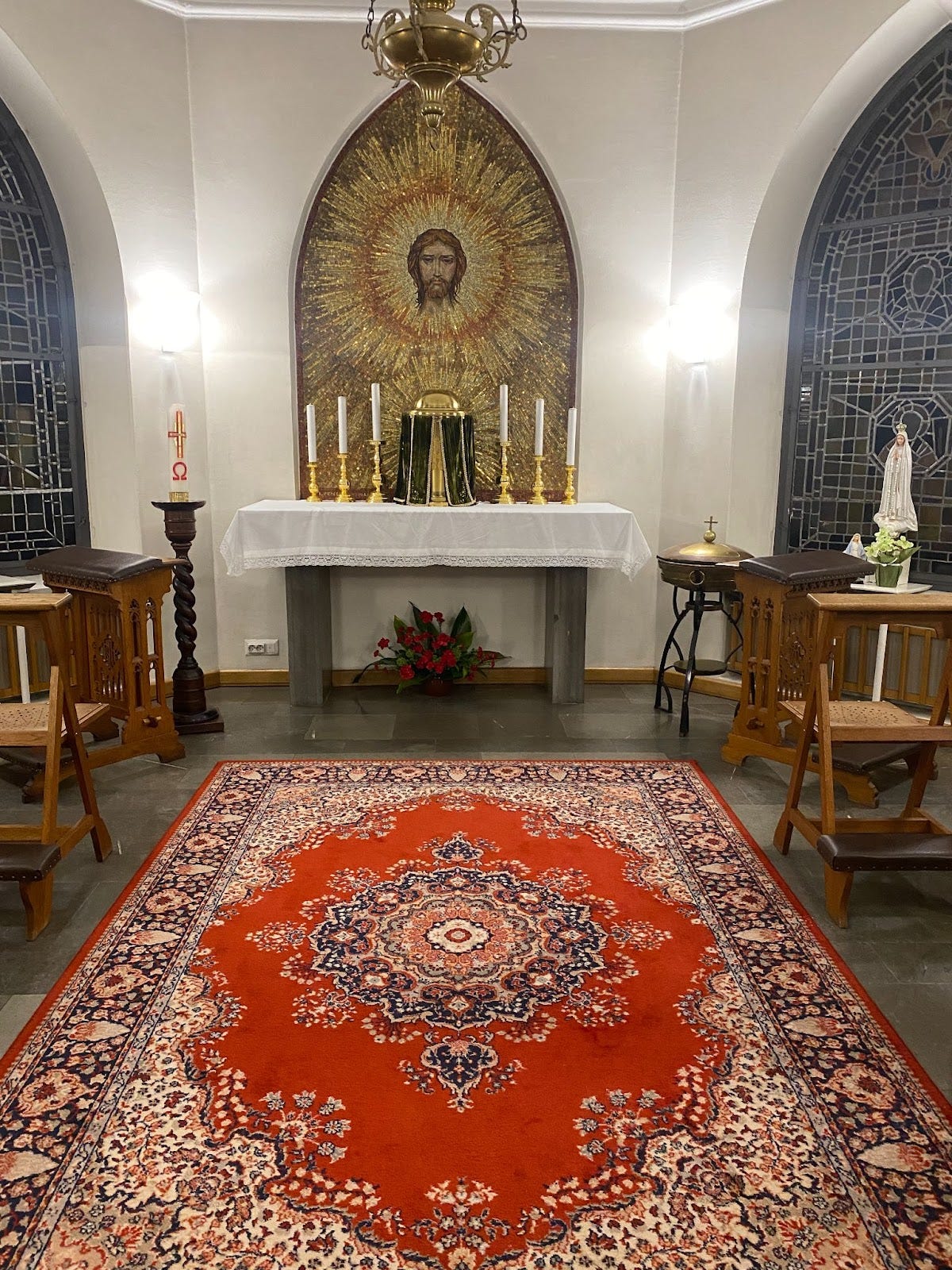
Fr. Kabeza is himself a demonstration of the international flavor of the Finnish Church.
“I come from Butare, in the south of Rwanda. I grew up in a Catholic family –even my great-grandparents were Catholic– so I was an altar server from the age of eight. That was my way to be close to Jesus Christ from an early age and start thinking about priesthood, especially after I went to a Catholic high school,” he says.
“But when I was finishing high school, the genocide in Rwanda happened. So, I fled with my family as refugees first to the Democratic Republic of Congo, and then to the other Congo. Then, in Congo, I decided to enter seminary. I was sent to study philosophy in Cameroon, but at this point the United Nations chose us through a refugee program to go to Finland.”
“So, with the blessing of my bishop, I moved to Finland in 2005.”
But Fr. Kabeza’s journey took a while to complete.
He could not immediately resume seminary studies, he told me, because he had to go through an integration plan which included learning Finnish from scratch and working for a while. He then studied nursing, while serving Mass at the cathedral.
After graduating, he worked as a nurse at a local hospital for a year. When he asked the bishop to continue his seminary studies, he was sent to Lyon in 2011. He returned in 2017 to be ordained a deacon, and later that year, a priest.
Still, the diversity does not mean the Church in the country is devoid of Finnishness.
Many migrants who have settled in the country go to Mass in Finnish rather than English. And there is a significant number of second-generation migrants who were raised in Finland and are fully bilingual. “I don’t look Finnish, but I speak the language like a Finn, and in many ways feel like a Finn,” a second-generation migrant parishioner originally from Spain tells me.
Plus, the Church receives a significant number of Finnish converts every year, and there are a few Finnish cradle Catholics—the children and grandchildren of the first generation of converts, who entered the Church through the apostolate of Dutch Dehonians priests who started evangelizing the country in the 1920s, when freedom of worship was instituted in Finland.
Fr. Kabeza tells me that this year about 40 Finnish Lutherans are in catechesis to be received in the Catholic Church in Easter in Helsinki.
“There’s also a group of seven people from China and other countries receiving catechesis in English to be baptized, and on Christmas we baptized two people, one from India, and one from Pakistan,” he says.
I’ve been told by Bishop Raimo Goyarrola that about 250 people are received in the Catholic Church each year.
“We’re in Finland, so our main work is in Finnish, but you also have to adapt for people. Finnish is a very, very difficult language. There are refugees traumatized by war that can simply can’t dedicate themselves to the task of learning the language,” Fr. Kabeza says.
“There are others working two jobs, they don’t have the time. And there are others who come to Finland at an age where it’s hard to learn new languages, so you have to integrate them, encourage them to learn the language but also understand their circumstances,” he says.
“Many times I think we’re doing more than the government for integration. For example, some Vietnamese migrants have a hard time dealing with bureaucracy or going to the doctor. They might give them a translator but they don’t trust the translator. But if Father Joseph, who is from Vietnam, is with them and helps them, they feel more at ease, they can discuss their problems, because he’s a priest, so they trust him.”
–
On Sunday, I attend Mass at the cathedral.
The first Mass is in English at 9:30 a.m. I get there a little after 9:00 to find that the church is nearly 70% full already. The community is praying the rosary.
I notice that there’s not enough sunlight at this point in the morning to light up the beautiful glass windows of the cathedral.
By 9:15, there is no more seating available. A few minutes later, I give my seat to an African woman with two small children. I see there is a good number of people standing in the back. Some go up to the choir to sit –or stand– there.
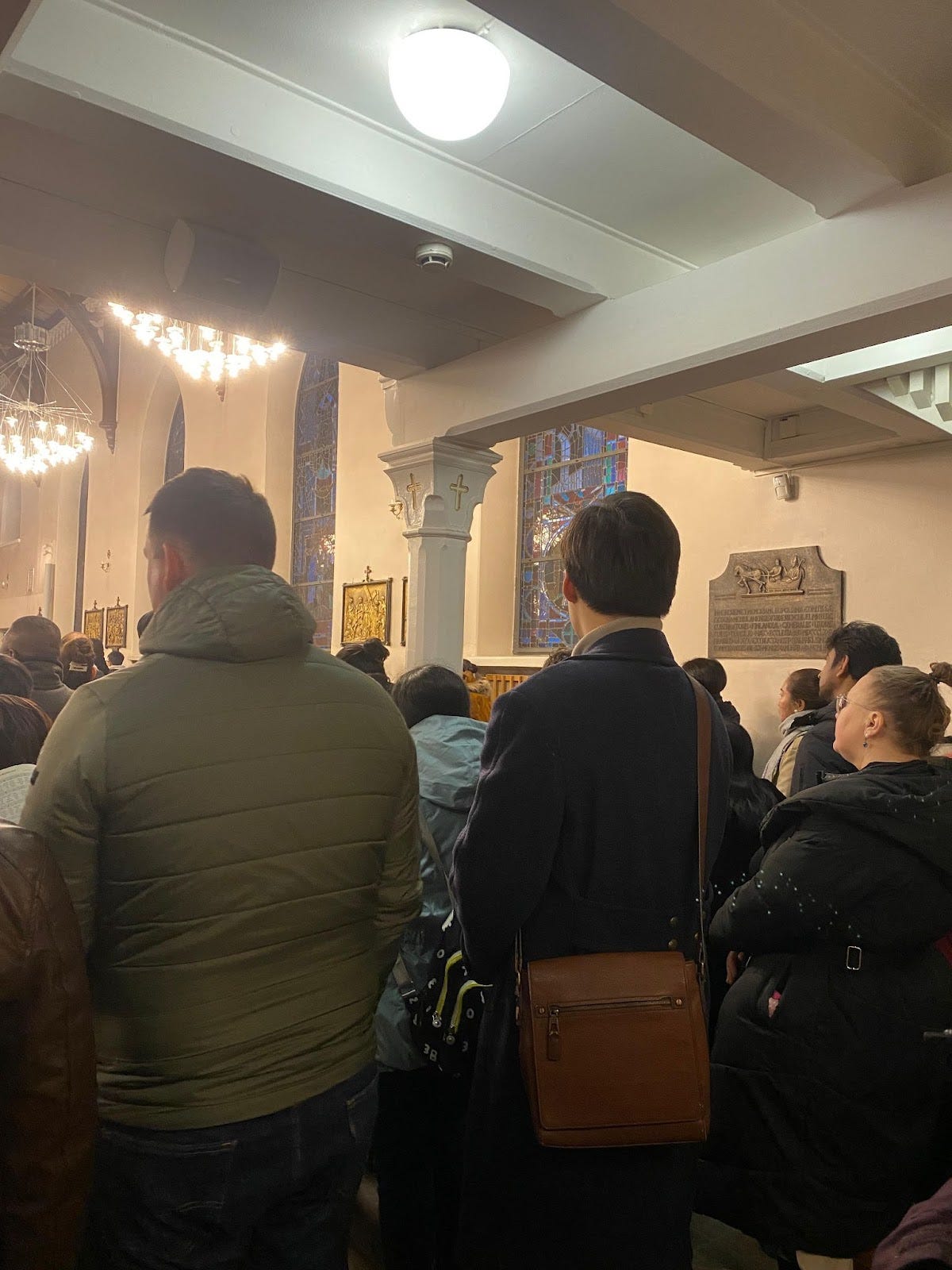
It seems disorganized. People sit where they can, even in the stairs that lead to the choir or in the side chapel where the Blessed Sacrament is reserved. Some give their places to women with children or older people, or stand in the hallway right at the entrance of the church.
It’s chaotic, but somehow reverent. At no point does the community stop praying the Rosary or start chatting.
All kinds of people are present at the Mass. Only a small minority of the congregation seems to have English as their first language. There are a lot of Filipinos, Sri Lankans, Indians, people from all over Africa, especially Nigeria and Cameroon, and some Europeans and Latin Americans. All the altar servers are Filipino, while the priest, Fr. Manuel, is a Spaniard who speaks English with a thick Spanish accent.
“It’s Catholicity,” Fr. Kabeza says to me later that day. “It’s unity in diversity.”
After the Mass, people gather in the parish, where a light meal is served—some typical Finnish pastries, sandwiches, coffee and tea.
I introduce myself to the people serving the meal and tell them I’m a journalist. A Filipino lady called Socorro agrees to talk to me.
“I came here in 2007 with an Italian diplomat,” she tells me. “I had been with him first in Israel and then I came to Finland.”
I ask her if she has mastered the Finnish language.
She laughs.
“At first only the bad words,” she says, to the laughter of the other people serving the meal.
“You always need to know the bad words because you don’t know if people are saying them to you on the street.”
“I started learning but then I always forget the language whenever I go back to the Philippines,” she says, laughing again.
“At my age, your tongue is too stiff to learn a new language,” she adds. “But I do understand Finnish, it’s just very hard for me to speak sometimes.”
I ask her if she’s seen the Catholic community change in the last few years. She tells me yes, because there’s more diversity now.
“There are more Filipinos and more people from other countries like India, so there are more nationalities. But people have always been very welcoming, it’s a good community.”
I take a piece of pastry. I ask the name of it, but I don’t understand the answer.
Next I speak with Anthony, a 22-year-old student from Cameroon. He tells me he came here four years ago, with his mother Ivette, who watches beaming with pride while I speak with him.
He talks to me about his plans—he just started studying engineering, he already speaks Finnish. Then, I ask him about his faith: What’s it like to be a Catholic migrant in Finland?
He smiles. “Well, church was a bit more exciting back home,” he says laughing. “You know, people dance and sing at church, here’s a bit different.”

“But it’s fine, people are very welcoming and nice. So, I don’t mind, even if it’s different.”
“And with Finnish people, you know, they aren’t usually Christians, but I have Finnish friends and they respect my faith. When people are really friends, it doesn’t matter if you’re Catholic, atheist, or Muslim, you’re friends and you care for each other, and that’s it.”
While I’m talking to Anthony, another Cameroonian joins us. His name is Thomas. He’s a middle-aged man who came to Finland in 2004 to pursue his master’s in public policy in Jyväskylä, a city 160 miles north of Helsinki. Now he is a lecturer and researcher at the University of Helsinki.
I ask him if he’s seen the Church change much over the years. He says, aside from the numbers, not really. “The core is the same, which is the faith. Now you have more immigrants from different countries and we have African priests like Fr. Jean Claude, but the essence remains.”
We talk a bit about Finnish politics—the hotly-contested presidential elections are being held that day. He repeatedly tells me he will go to vote after church, but he tells me he will go to the African Mass first.
I tell him I intend to go too, so we hop on the tram together.
I ask him about the story of the Mass for the African community. He tells me it started about seven years ago, as the number of African Catholics grew in Helsinki. The Mass was originally celebrated at St. Mary’s, the other Catholic parish in Helsinki, but as the community grew, they had to go somewhere else.
The community of the Kallio Kirkko, one of the landmark Lutheran churches of Helsinki, received them and allowed them to move the Mass to their church a couple of years ago.
I get to the church with Thomas after talking Venezuelan and Cameroonian politics on the way.
The Kallio Kirkko is an imposing church built in the Nordic art nouveau style prevalent in the early 20th century in Finland.
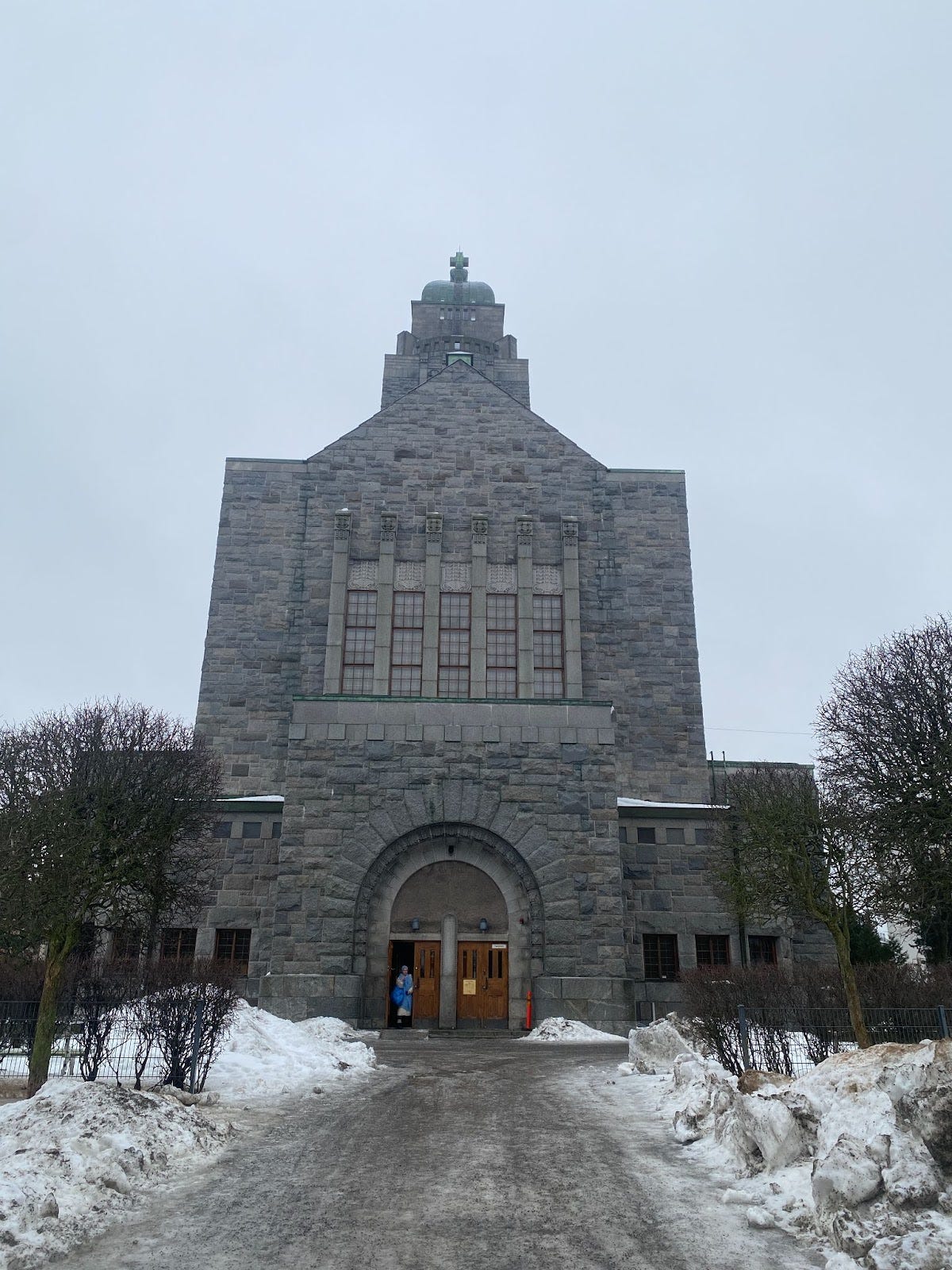
The community is not small. Around 120 people show up for Mass, although I’m told that when the winter ends, the community usually doubles in size.
However, the church seats 1100, which makes it feel a bit underwhelming.
“You know, some people simply can’t handle the cold, or have small children, lung issues, or something else, so they don’t go to church that often in the winter. But in November, there was a thanksgiving Mass for the ordination of Bishop Raimo and the church was completely full,” Fr. Kabeza told me later that day.
The Mass lasts over an hour and a half. The choir sings and dances. The priest, Fr. Thomas from Kenya, is in Helsinki for a few months in an exchange program. He is doing a master’s in education in Nairobi.
The homily is long, but people seem to enjoy it and laugh at Fr. Thomas’ jokes and anecdotes.
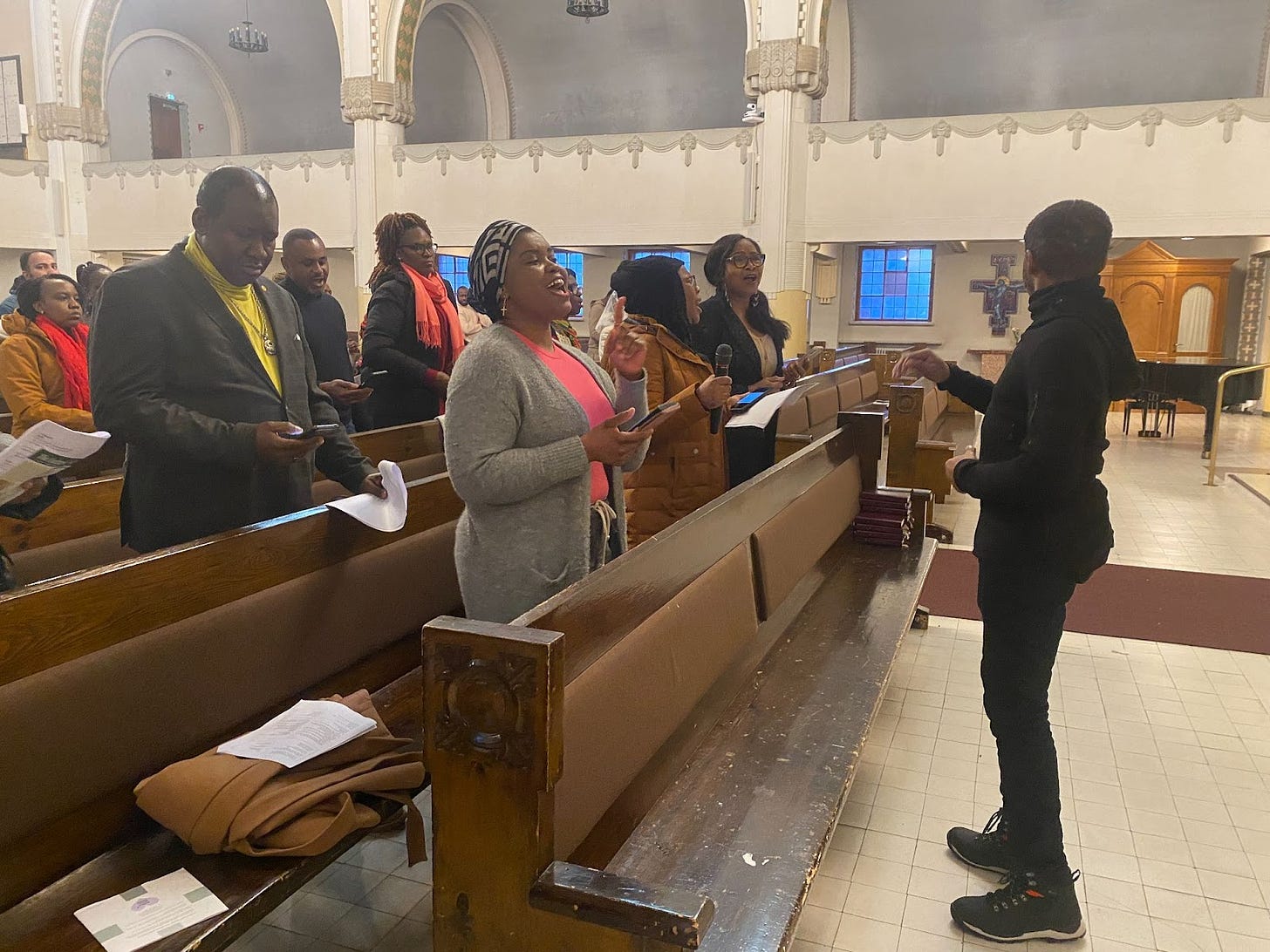
Despite the dancing and the joyful music, the environment is not relaxed or irreverent. The benches have no kneelers, but nearly everyone kneels from beginning to end of the Eucharistic prayer.
The church feels different after the consecration. The atmosphere changes.
Christ is in front of us.
The organist, who had been playing on an electrical keyboard, turns around to play the pipe organ of the Church while the choir sings the Agnus Dei in Latin.
I notice my watch after the priest says “go in peace.” It’s 1:37 p.m.—the Mass started at 12, but I have barely noticed the time pass.
After Mass, I greet the people in the choir. I speak with a Nigerian lady called Oby, who has been living in Finland for 30 years and is a restaurant manager.
“It’s fine to be Catholic in Finland. It’s not like in Nigeria, where you’re persecuted, here we’re safe,” she tells me.
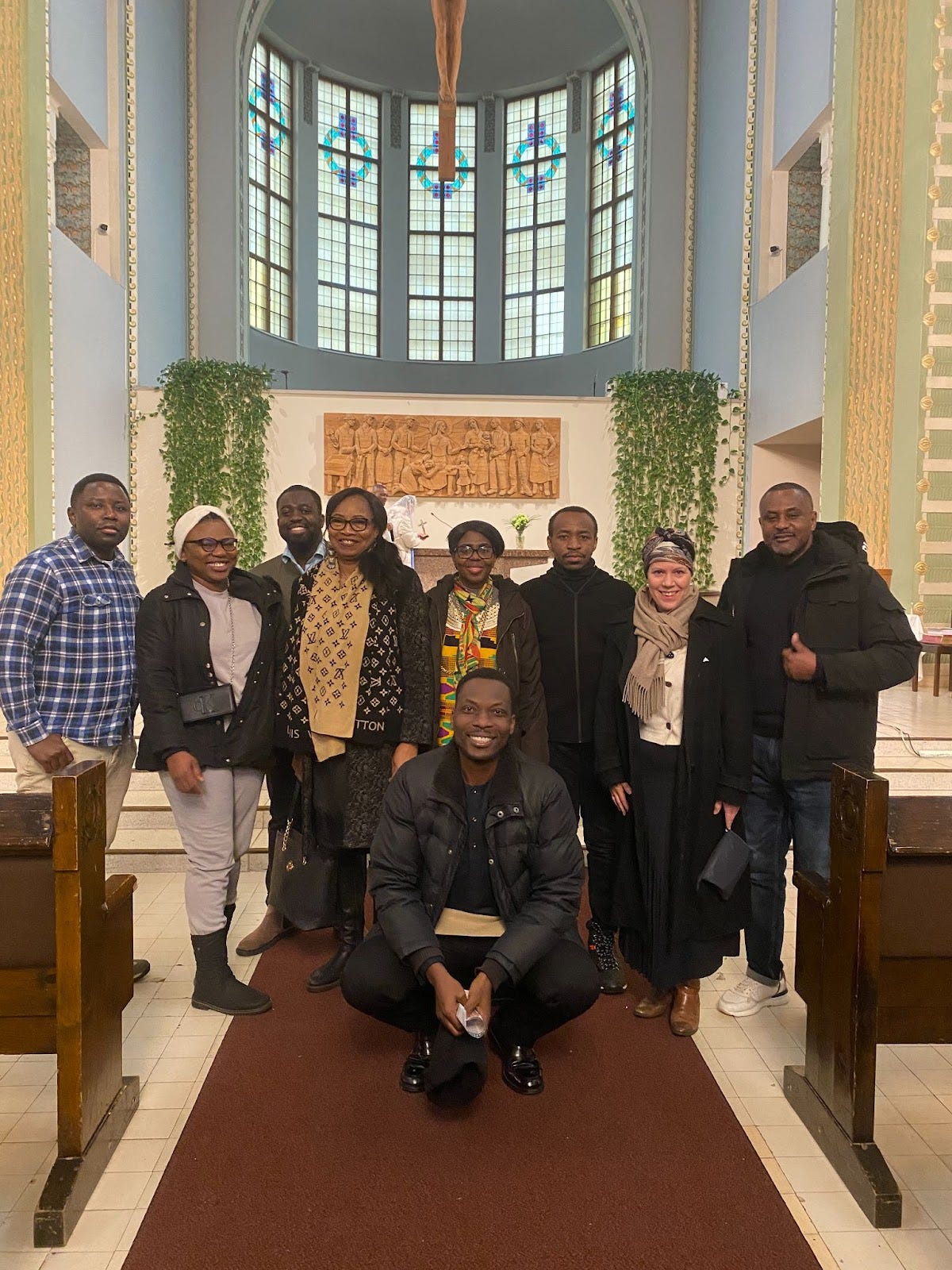
“And in this community there are people from all over Africa, they’re from Ghana,” she says, pointing toward Perpetua, one of the singers of the choir, and Samuel, one of the choir directors.
“There’s also people from Cameroon, Tanzania, Kenya, you name it. And we all sing together. Every week the Mass is organized by a different community, so all of us in the choir prepare and sing the songs from a different country. This week it was Nigeria, next week it’ll be Ghana,” she says.
“We have this Mass so we can worship like we do back home. We like to sing, we dance, so people can feel a bit more like home,” Thomas tells me.
Not all of the congregation is African.
One Finnish woman, called Hanne, says hello to other parishioners affectionately. She seems to be well-acquainted with them.
I ask her how long she has been coming to this Mass, “Two years now,” she tells me. “I’m actually a Lutheran,” she adds.
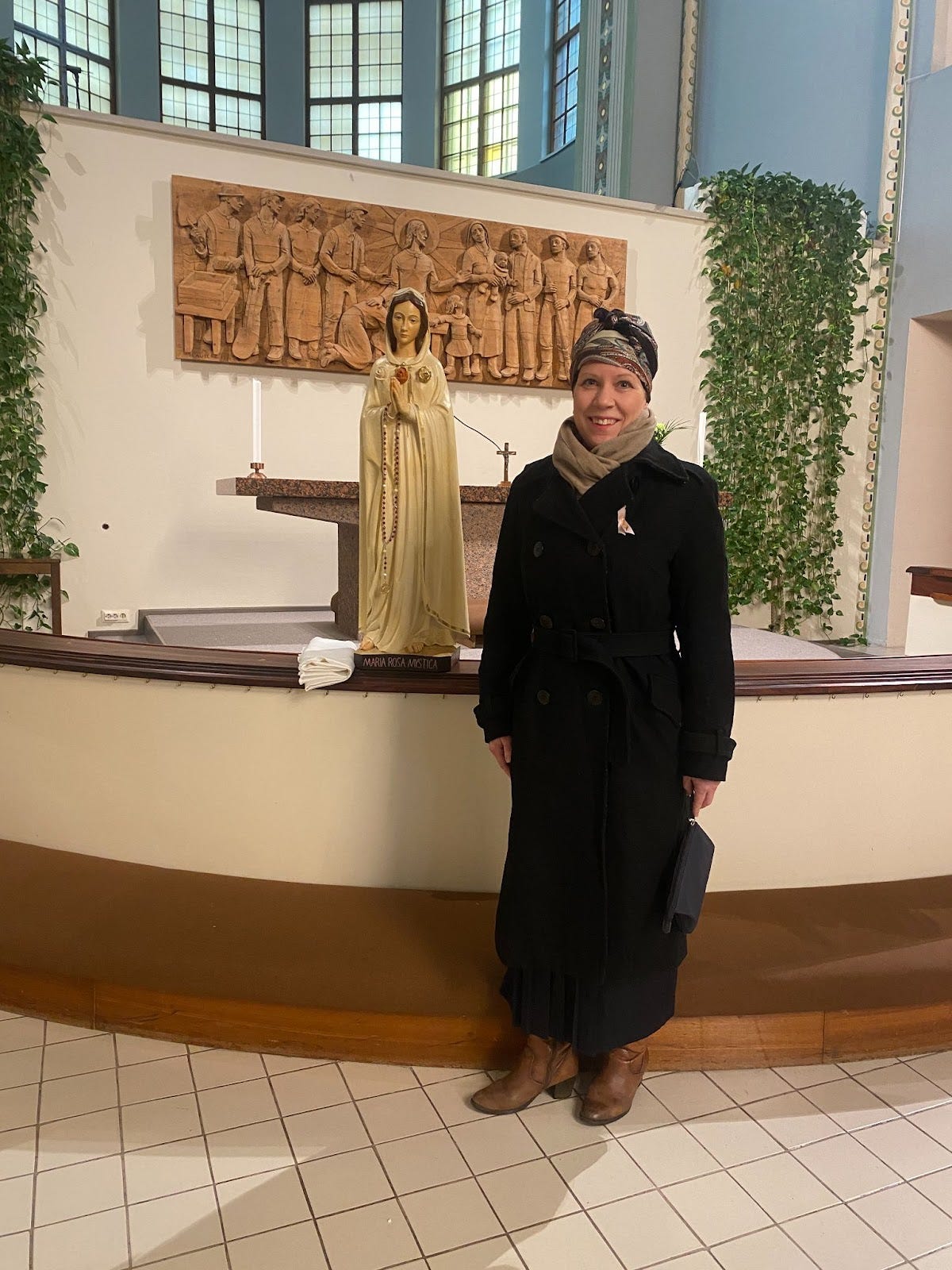
She pauses for a while. She points at the people and the church. “But this is more of my thing, I think. Yes, Catholicism is more of my thing. And I love Africa!” she adds, smiling. “I think I should probably start catechesis to join the Catholic Church sooner rather than later.”
I leave the church shortly after speaking with Hanne. I head back to the cathedral to talk with Fr. Kabeza.
I ask him if these Masses have always been so full. He tells me that it’s been slowly but surely growing, but the biggest growth came during and after the pandemic.
“We never closed our churches because of the pandemic. We had limits, only 12 people could come at a time, so we had more masses; six Masses on Sundays. Usually 20 people or so came, and I wasn’t going to kick them out,” he tells me.
“Lutheran churches were closed, so many Lutherans came to me asking if they could pray in the parish, and I told them that of course they could, the church doors are open for everyone. So they came, they prayed, and they went away. But then some of them spoke with me, we talked about the faith and eventually (they) converted.”
“Conversions increased since Covid, a lot of people called me saying that they were reflecting on their lives, on their relationship with God, so they started inquiring about the faith,” he says.
But he believes that the pillar of the strength of the Church in Finland is the family.
“If families are strong in the faith, they can transmit the faith to the younger generations; I see that here. People care about their faith, and about making it a central part of their lives. I see it in the Church, I see it when parents fight for their children’s education,” he says.
“Having the kindergarten run by the sisters helps because it makes people stay in touch with the parish and the sisters, they get more involved. They understand that it’s their responsibility to transmit the faith to their children, it is not only the work of the priest or the sisters,” he says.
“I think people appreciate the closeness of the Church. We try to go to them. We try to have compassion for those who cannot come that easily because traveling from another town is too costly or too difficult. So, we go to them,” he adds.
“Whether it is in a school gym, in a Lutheran church, or in one of our chapels, I don’t mind. We’re there with them and for them. We’re bringing Jesus to them, that’s what matters,” he says.
“I’ve been to Mass in a refugee camp. I found God in a refugee camp. What matters is Jesus,” he concludes.
I see the time. It’s past 5 p.m. I ask him if he doesn’t have to celebrate the evening Mass in less than an hour.
He hesitates. “Let me check,” he tells me, while pulling out a Mass schedule.
“Oh, yes,” he says smiling. “Another Mass.”
“And I also have half an hour of confessions before Mass,” he adds.
And Isä Jean Claude leaves his office for the sixth Sunday Mass at Saint Henry’s cathedral.
